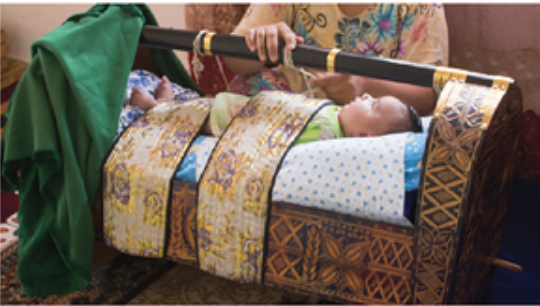Exploring ‘Blind Spots’ in the Science of Child Development
Blog Post

Photo of gahvora cradle in Tajikistan from PLOS One 2018 article by Karasik et al
Oct. 21, 2019
The Learning Sciences Exchange (LSX) is a cross-sector fellowship program designed to bring together journalists, entertainment producers, policy influencers, and researchers around the science of early learning. As part of the program, our fellows contribute to various publications, including New America’s EdCentral blog; BOLD, the blog on learning development published by the Jacobs Foundation; and outside publications. The article below, by LSX Fellow Sujata Gupta, is excerpted from a September 10th article in Science News: Culture Helps Shape When Babies Learn to Walk.
For generations, farther back than anyone can remember, the women in Rano Dodojonova’s family have placed their babies in “gahvoras,” cradles that are part diaper, part restraining device. Dodojonova, a research assistant who lives in Tajikistan, was cradled for the first two or three years of her life. She cradled her three children in the same way.
Ubiquitous throughout Central Asia, the wooden gahvora is often a gift for newlyweds. The mother positions her baby on his back with his bottom firmly over a hole. Underneath is a bucket to capture whatever comes out. She then binds the baby with several long swaths of fabric so that only the baby’s head can move. Next, she connects a funnel, specially designed for either boys or girls, to send urine out to that same bucket under the cradle. Finally, she drapes heavy fabric over the handle atop the gahvora to protect the child from bright light and insects.
Babies stay in that womblike apparatus for hours on end, with use decreasing as the child ages. When babies fuss, mothers often shush them by vigorously rocking the cradle back and forth or leaning over the side to breastfeed. Besides keeping babies dry and warm, gahvoras provide a sense of safety, Dodojonova says. “It is very nice for children because they are bound and cannot move.” Eventually, they are running and jumping like children everywhere.
To the uninitiated, this child-rearing approach may sound odd, or even shocking. Yet cultures should be viewed within their own context, says psychologist Catherine Tamis-LeMonda of New York University. “We engage in practices that fit our needs, our own everyday lives.” ….
To continue reading, see the full article published September 10th in Science News.